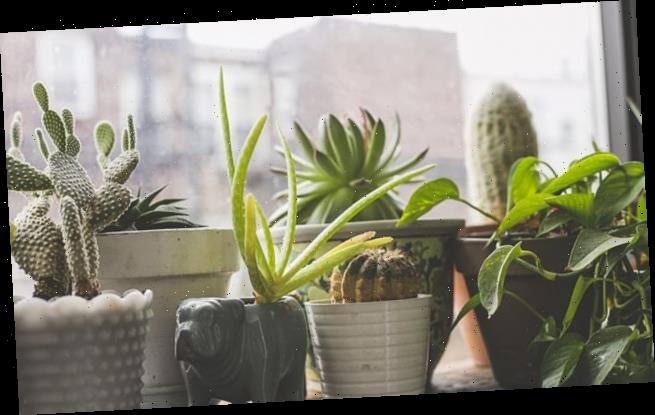Houseplants DON’T improve indoor air quality: Scientists claim you need 93 plants per square foot of floor space to make a difference — and you’re better off opening a window
- Researchers reviewed decades of studies into plants’ air cleaning effects
- Previous experiments in contained environments were unrealistic, they found
- Ventilation systems — or just opening a window — are vastly more effective
- Plants clean harmful chemicals out of the air too slowly to be significant
- As many as 93 plants per square foot would be needed to have a real effect
The notion that houseplants can meaningfully improve indoor air quality is ‘simply a myth’, a new study has found — with potted plants being practically as useful.
Researchers found that it would take up to 93 plants per square foot of floor space to compete with an office ventilation system.
The same effect can also be achieved in a house by opening a couple of windows.
Pot plants may brighten up our homes and office spaces — but their atmosphere-cleansing abilities are ‘vastly over-stated’, the team conclude.
By reviewing decades of studies, experts found that plants soak up dangerous chemicals too slowly to have any kind of significant impact.
Scroll down for video
The notion that houseplants can meaningfully improve indoor air quality is ‘simply a myth’, a new study has found — with potted plants being practically as useful
‘This has been a common misconception for some time,’ said paper author and environmental engineer Michael Waring of the Drexel University in Philadelphia.
‘Plants are great, but they don’t actually clean indoor air quickly enough to have an effect on the air quality of your home or office environment.’
Professor Waring and colleagues found instead that ventilation systems — or even opening a window — reduce volatile organic compounds (VOCs) much quicker than plants can extract them from the air.
These potentially toxic chemicals are released by everything from paint and printers to cleaning chemicals and dry-cleaned clothes.
The Royal College of Physicians has estimated that indoor air pollution contributes to 99,000 deaths in Europe every year.
Many people also believe they suffer from ‘sick building syndrome’, in which stagnant, polluted air is blamed for triggering various ailments from headaches to skin allergies and fatigue.
To counter this, indoor plants are frequently touted as ‘natural air fresheners’.
However a review of a dozen papers investigating this potential over the last three decades by Professor Waring and colleague Bryan Cummings has shown that potted plants are no better at cleaning the air than their artificial counterparts.
The misconception was fostered by the results of a high-profile test in 1989, which NASA used to suggest that plants could be used to soak up cancer-causing molecules and clean the air contained within space stations.
However, the problem with this experiment — and others like it — is that such were conducted in a sealed chamber in a laboratory setting, the researchers argue.
A contained environment has little in common with a house or office, they said — and these studies were not taken any further.
‘Typical for these studies, a potted plant was placed in a sealed chamber — often with a volume of a cubic metre or smaller — into which a single VOC was injected,’ explained Prof Waring.
‘Its decay was tracked over the course of many hours or days.’
A review of a dozen papers investigating the air purifying potential of plants by Professor Waring and colleague Bryan Cummings has shown that potted plants are no better at cleaning the air than their artificial counterparts, pictured
To determine how plants real in more realistic settings would fare, the research due pooled the results of previous studies to create a measure dubbed the clean air delivery rate, or CADR.
From this, they demonstrate that, in every previous study, the rate at which plants dissipate VOCs in a chamber was orders of magnitude slower than the standard rate of air exchange in a building.
This means that the overall effect of potted plants on indoor air quality is practically inconsequential.
‘The CADR is the standard metric used for scientific study of the impacts of air purifiers on indoor environments,’ said Professor Waring.
‘But many of the researchers conducting these [past] studies were not looking at them from an environmental engineering perspective and did not understand how building air exchange rates interplay with the plants to affect indoor air quality.’
Many did show a slow reduction in the concentration of VOCs over time, however, which explains why people have seized upon the findings to extol the air purifying virtues of plants, he said.
Yet, he noted, it would take between 1–93 plants per square foot to compete with the air cleaning capacity of a building’s air ventilation system — or even just a couple of open windows in a house.
‘This is certainly an example of how scientific findings can be misleading or misinterpreted over time,’ noted Professor Waring.
‘But it’s also a great example of how scientific research should continually re-examine and question findings to get closer to the ground truth of understanding what’s actually happening around us.’
The full findings of the study were published in the Journal of Exposure Science and Environmental Epidemiology.
WHAT IS AIR POLLUTION?
Emissions
Carbon dioxide
Carbon dioxide (CO2) is one of the biggest contributors to global warming. After the gas is released into the atmosphere it stays there, making it difficult for heat to escape – and warming up the planet in the process.
It is primarily released from burning fossil fuels such as coal, oil and gas, as well as cement production.
The average monthly concentration of CO2 in the Earth’s atmosphere, as of April 2019, is 413 parts per million (ppm). Before the Industrial Revolution, the concentration was just 280 ppm.
CO2 concentration has fluctuated over the last 800,000 years between 180 to 280ppm, but has been vastly accelerated by pollution caused by humans.
Nitrogen dioxide
The gas nitrogen dioxide (NO2) comes from burning fossil fuels, car exhaust emissions and the use of nitrogen-based fertilisers used in agriculture.
Although there is far less NO2 in the atmosphere than CO2, it is between 200 and 300 times more effective at trapping heat.
Sulfur dioxide
Sulfur dioxide (SO2) also primarily comes from fossil fuel burning, but can also be released from car exhausts.
SO2 can react with water, oxygen and other chemicals in the atmosphere to cause acid rain.
Carbon monoxide
Carbon monoxide (CO) is an indirect greenhouse gas as it reacts with hydroxyl radicals, removing them. Hydroxyl radicals reduce the lifetime of carbon dioxide and other greenhouse gases.
Particulates
What is particulate matter?
Particulate matter refers to tiny parts of solids or liquid materials in the air.
Some are visible, such as dust, whereas others cannot be seen by the naked eye.
Materials such as metals, microplastics, soil and chemicals can be in particulate matter.
Particulate matter (or PM) is described in micrometres. The two main ones mentioned in reports and studies are PM10 (less than 10 micrometres) and PM2.5 (less than 2.5 micrometres).
Air pollution comes from burning fossil fuels, cars, cement making and agriculture
Scientists measure the rate of particulates in the air by cubic metre.
Particulate matter is sent into the air by a number of processes including burning fossil fuels, driving cars and steel making.
Why are particulates dangerous?
Particulates are dangerous because those less than 10 micrometres in diameter can get deep into your lungs, or even pass into your bloodstream. Particulates are found in higher concentrations in urban areas, particularly along main roads.
Health impact
What sort of health problems can pollution cause?
According to the World Health Organization, a third of deaths from stroke, lung cancer and heart disease can be linked to air pollution.
Some of the effects of air pollution on the body are not understood, but pollution may increase inflammation which narrows the arteries leading to heart attacks or strokes.
As well as this, almost one in 10 lung cancer cases in the UK are caused by air pollution.
Particulates find their way into the lungs and get lodged there, causing inflammation and damage. As well as this, some chemicals in particulates that make their way into the body can cause cancer.
Deaths from pollution
Around seven million people die prematurely because of air pollution every year. Pollution can cause a number of issues including asthma attacks, strokes, various cancers and cardiovascular problems.
Asthma triggers
Air pollution can cause problems for asthma sufferers for a number of reasons. Pollutants in traffic fumes can irritate the airways, and particulates can get into your lungs and throat and make these areas inflamed.
Problems in pregnancy
Women exposed to air pollution before getting pregnant are nearly 20 per cent more likely to have babies with birth defects, research suggested in January 2018.
Living within 3.1 miles (5km) of a highly-polluted area one month before conceiving makes women more likely to give birth to babies with defects such as cleft palates or lips, a study by University of Cincinnati found.
For every 0.01mg/m3 increase in fine air particles, birth defects rise by 19 per cent, the research adds.
Previous research suggests this causes birth defects as a result of women suffering inflammation and ‘internal stress’.
What is being done to tackle air pollution?
Paris agreement on climate change
The Paris Agreement, which was first signed in 2015, is an international agreement to control and limit climate change.
It hopes to hold the increase in the global average temperature to below 2°C (3.6ºF) ‘and to pursue efforts to limit the temperature increase to 1.5°C (2.7°F)’.
Carbon neutral by 2050
The UK government has announced plans to make the country carbon neutral by 2050.
They plan to do this by planting more trees and by installing ‘carbon capture’ technology at the source of the pollution.
Some critics are worried that this first option will be used by the government to export its carbon offsetting to other countries.
International carbon credits let nations continue emitting carbon while paying for trees to be planted elsewhere, balancing out their emissions.
No new petrol or diesel vehicles by 2040
In 2017, the UK government announced the sale of new petrol and diesel cars would be banned by 2040.
From around 2020, town halls will be allowed to levy extra charges on diesel drivers using the UK’s 81 most polluted routes if air quality fails to improve.
However, MPs on the climate change committee have urged the government to bring the ban forward to 2030, as by then they will have an equivalent range and price.
The Paris Agreement, which was first signed in 2015, is an international agreement to control and limit climate change. Pictured: air pollution over Paris in 2019.
Norway’s electric car subsidies
The speedy electrification of Norway’s automotive fleet is attributed mainly to generous state subsidies. Electric cars are almost entirely exempt from the heavy taxes imposed on petrol and diesel cars, which makes them competitively priced.
A VW Golf with a standard combustion engine costs nearly 334,000 kroner (34,500 euros, $38,600), while its electric cousin the e-Golf costs 326,000 kroner thanks to a lower tax quotient.
Criticisms of inaction on climate change
The Committee on Climate Change (CCC) has said there is a ‘shocking’ lack of Government preparation for the risks to the country from climate change.
The committee assessed 33 areas where the risks of climate change had to be addressed – from flood resilience of properties to impacts on farmland and supply chains – and found no real progress in any of them.
The UK is not prepared for 2°C of warming, the level at which countries have pledged to curb temperature rises, let alone a 4°C rise, which is possible if greenhouse gases are not cut globally, the committee said.
It added that cities need more green spaces to stop the urban ‘heat island’ effect, and to prevent floods by soaking up heavy rainfall.
Source: Read Full Article





